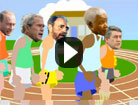I’ve just come back from taking my dad to visit his family in Singapore and Malaysia. I was reading ‘One From Many’ by Dee Hock on the way (in between watching Spider Man 3).
Large organizations (in fact all organizations) are still struggling with this basic problem: how to treat large numbers of people as individuals. I think of it as the ‘one and the many’ problem, which is why Hock’s book title appealed to me.
Anyway, it struck me that it can be done, and the flight was an example. I was watching the Singapore Airline cabin crew move down the plane towards us, with headsets or something they were handing out, and every person they handed one to – even though the connection was a second or less – received a very real smile. In less than a second, there was a personal engagement and acknowledgement, repeated hundreds of times down the plane.
This is no mean feat, as we can all tell, instinctively, the difference between a real and a fake smile. There is something called The Duchenne Smile*. And there is what some have dubbed the ‘Pan Am smile’ – the meaningless, ‘have a nice day’ smile that accompanies most service transactions.
The chairman of The Henley Centre for Research told me a few years ago that, despite all the investment in sophisticated Customer Relationship Management systems and automated call centres, the future for customer relations lies in the return of real people interacting with real people, because that’s what customers want in most cases.
He’s clearly right. It’s just a question of resolving that ‘one and many’ thing.
* (From Wikipedia if you can’t be bothered to click above):
The “Duchenne smile”, after the researcher Guillaume Duchenne, is the most studied, and involves the movement of both the zygomaticus major muscle near the mouth and the orbicularis oculi muscle near the eyes. An example of the smile is shown in the girl’s smile in the middle of the page. It is believed that the Duchenne smile is only produced as an involuntary response to genuine emotion, and is therefore what one could call the “genuine” smile. Due to the involvement of the muscle near the eyes, it is sometimes said that one can tell whether or not a smile is “real” by whether or not it “reaches the eyes”.
The “Pan American smile”, on the other hand, is the voluntary smile involving only the zygomaticus major muscle to show politeness; for example, by a flight attendant on the former airline of the same name. Considered “insincere”, this type of smile has also been called the “Professional Smile” by David Foster Wallace in his comedic short story “A Supposedly Fun Thing I’ll Never Do Again”.









Leave a Reply